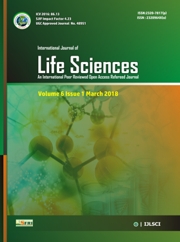OVERVIEW
Volume 7 |Issue 1| January-Febrary 2019
First published: 28 February 2019
An overview of earth and its atmospheric processes
Gupta Swaroopa Rani N (Ph.D.)
Department of Chemistry, Brijlal Biyani Science College Amravati, Maharashtra, India
*Correspondence author’s Email: Email: swargupta@yahoo.com
Abstract
Latitude is distance north or south of the equator and longitude is distance east or west of the prime meridian of a circle. The Equator is the line of 0° latitude, the starting point for measuring latitude. A prime meridian is a meridian (a line of longitude) in a geographic coordinate system at which longitude is defined to be 0°. Tropic of Cancer, Tropic of Capricorn, Arctic and Antarctic Circles and the Equator are five major circles of latitude that mark maps of Earth. The Earth has a substantial magnetic field that is thought to be due to the movement of the charged particles in the liquid core. The Earth is surrounded by two regions of particularly high concentration of charged particles called the Van Allen radiation belts. These charged particles trapped in the Earth's magnetic field are responsible for the aurora (Northern and Southern Lights) seen in the sky around the poles. UV-c (red) is entirely screened out by ozone around 35 km altitude. On the other hand, most UV-a (blue) reaches the surface, but it is not as genetically damaging. It is the UV-b (green) radiation that can cause sunburn and that can also cause genetic damage, resulting in things like skin cancer, if exposure to it is prolonged. It is in the lower part of the magnetosphere that overlaps with the ionosphere that the spectacular displays of the aurora borealis and aurora australis take place. The magnetosphere also contains the Van Allen radiation belts, where highly energized protons and electrons travel back and forth between the poles of Earth’s magnetic field. The ionosphere was thought to be composed of a number of relatively distinct layers that were identified by the letters D, E, and F. The F layer was subsequently divided into regions F1 and F2. Electron density increases more or less uniformly with altitude from the D region, reaching a maximum in the F2 region. The solar wind compresses the magnetic field on Earth’s dayside at a distance of about 10 Earth radii. On the nightside, the terrestrial field is stretched out in a giant tail that reaches past the orbit of the Moon, extending perhaps to distances in excess of 1,000 Earth radii. Most of the electrical activity in the ionosphere is produced by photoionization. Ionization in the F1 region is produced mainly by ejection of electrons from molecular oxygen (O2), atomic oxygen (O), and molecular nitrogen (N2). The threshold for ionization of O2, O and N2 corresponds to a wavelength of 102.7 nm, 91.1 nm and 79.6 nm respectively. In the D region, NO+ and water vapour (H2O) can interact to form the hydronium ion, H3O+, and companion species such as H5O2+ and H7O4+. Production of hydrated ions is limited by the availability of H2O. As a consequence, they are confined to altitudes below about 85 km (53 miles). The electron density in the D, E, and F1 regions reflects for the most part a local balance between production and loss. Electrons are removed mainly by dissociative recombination, a process in which electrons attach to positively charged molecular ions and form highly energetic, unstable neutral molecules. These molecules decompose spontaneously, converting internal energy to kinetic energy possessed by the fragments. The most important processes in the ionosphere involve recombination of O2+ and NO+.
Ions and electrons produced at high altitude are free to diffuse downward, guided by Earth’s magnetic field. This paper deals with an overview of earth and its atmospheric processes which in turn is valuable for understanding different phenomenon of Auroras the most spectacular manifestations of the complex interaction of the solar wind with the outer atmosphere.
Keywords: Latitude, Longitude, Tropic of Cancer, Tropic of Capricorn, Earth's Magnetic Field, Electromagnetic spectrum, Ionosphere, Magnetosphere, Photoionization, Recombination, Diffusion
Additives
Editor: Dr.Arvind Chavhan
Cite this article as:
Gupta Swaroopa Rani N. An overview of earth and its atmospheric processes. Int. Res. Journal of Science & Engineering, 2019, 7 (2): 8-16.
References
1. https://www.geovista.psu.edu/grants/MapStatsKids/MSK_portal/concepts_latlg.html
2. https://www.britannica.com/science/latitude
3. Obliquity of the ecliptic (Eps Mean)
4. https://en.wikipedia.org/wiki/Tropic_of_Capricorn#/media/File:Axial_tilt_vs_tropical_ and_polar_circles.svg
5. https://www.britannica.com/science/ionosphere-and-magnetosphere
6. https://en.wikipedia.org/wiki/Electromagnetic_spectrum#/media/File:Atmospheric_ electromagnetic_opacity.svg
7. https://en.wikipedia.org/wiki/Electromagnetic_spectrum#/media/File:Ozone_altitude _UV_graph.svg
8. https://www.slideshare.net/MiningMatters/earths-structure-21971514
9. https://www.britannica.com/science/ionosphere-and-magnetosphere? oasmId=99826
10. https://www.britannica.com/science/ionosphere-and-magnetosphere? oasmId=167048
11. https://www.britannica.com/science/ionosphere-and-magnetosphere
12. https://www.britannica.com/science/ionosphere-and magnetosphere/ Magnetosphere#ref 272038
13. https://www.britannica.com/science/ionosphere-and-magnetosphere# ref272032

